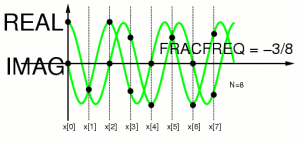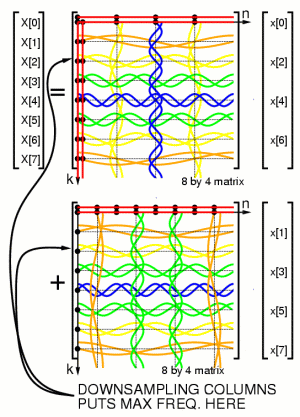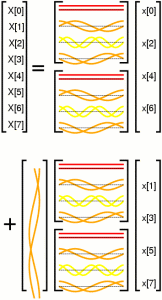Sampling of cosines:

(click to see the various cosines sampled).
Let us first begin by understanding the DFT (Discrete Fourier Transform),
of which the FFT is a fast (computationally efficient) implementation.
The DFT provides a comparison (correlation, inner product) of an arbitrary
input signal with a complex exponentials (cosines and sines) at various
frequencies. Here, for example, we see a cosine wave sampled at
various frequencies:
Sampling of cosines:

(click to see the various cosines sampled).
Fractional frequency is a circular concept, yet when we sample a cosine at a fractional frequency of +5/8 (e.g. 8 samples per second and 5 cycles per second), we get the same result as sampling at +3/8. We'd really like to be able to know the difference between positive and negative frequencies, so that, for example, +5/8 is equialent to -3/8. To do this, we use complex signals, where the real part is a cosine wave, and the imaginary part is a sine wave. Thus, for example, a fractional frequency of +5/8 aliases to a fractional frequency of -3/8. In this way, frequency is a circular concept, as it should be.
Aliasing as negative frequency:

Thus there are, for example, eight unique frequencies in a signal
that has eight samples.
We can also "fftshift" these eight frequency components so that they
are ordered from negative to positive frequency:
Reordering into negative frequencies

Similarly, if we desire, we can also shift the time origin to the center
(e.g. in Octave or Matlab, we can use the fftshift() function in both time and
frequency):

If we take enough of these sines and cosines, along rows of a large matrix,
e.g. for a 1024 point DFT, the cosines will make a 1024 by 1024 matrix,
and so will the sines. The central portion of a Fourier transform
matrix looks like this:
 (Real part)
(Real part)
 (Imag. part)
(Imag. part)
The Fourier Transform can be computed as a matrix multiplication:

The 8 point DFT as a matrix multiplication:

To understand how the DFT can be more efficiently computed,
let us begin by separating this matrix multiplication into a sum of
two matrix multiplications, one for even columns, and one for odd columns:
Separation into even and odd columns:

Separation into even and even columns:

where the dot represents element by element (Hadamard) multiplication
(as would be denoted by ".*" if this were done in Octave or Matlab); the
dot will be omitted in the rest of this document, for simplicity,
where it is understood by dimensional consistency where it is assumed.
Decimation of columns by two gives aliasing:

thus the matrix repeats twice in the up-down direction:

so that we can write the 8point fourier operator as two four point
fourier operators:

therefore the DFT of 8 points can be expressed as two 4 point DFTs:

The above matrix equation can be implemented as a circuit:

Redundant elements of the circuit can be deleted:

Thus decimation in time has simplified the circuit design:
